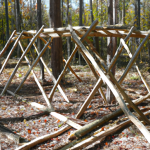
DIY Solar Oven: Harnessing the Sun’s Power for Off-Grid Cooking
When disaster strikes or you simply want to live a more self-reliant lifestyle, having the ability to cook without relying on traditional energy sources becomes a valuable skill. Enter the DIY solar oven. By harnessing the power of the sun, you can cook delicious meals while minimizing your impact on the environment and reducing your dependence on fossil fuels. In this guide, we will walk you through the process of making a simple, effective solar oven for off-grid cooking.
Materials You’ll Need:
- A cardboard box with a lid
- Aluminum foil
- Black construction paper
- A clear oven bag or a piece of glass
- A thermometer
- A ruler
- A utility knife or scissors
- Tape (preferably aluminum tape)
Step 1: Preparing the Box
- Choose a cardboard box that is sturdy and big enough to hold your cooking pots or pans. Remove any stickers or labels from the box.
- Seal the box with duct tape to reinforce its durability.
- Cut a flap in the top of the box, leaving at least 1 inch on all sides. This will serve as the oven’s lid.
- Line the inside of the box with aluminum foil, ensuring that it is smooth and reflective. Secure the foil with tape.
Step 2: Creating the Cooking Chamber
- Measure the inside dimensions of the box and cut a piece of black construction paper to fit the bottom.
- Tape the black construction paper to the inside bottom of the box. This will absorb the sun’s heat and help with the cooking process.
- Place a cooking rack (e.g., a wire cooling rack) on top of the black construction paper to elevate your cooking pots or pans.
Step 3: Insulating the Box
- Cut pieces of cardboard to fit snugly around the sides of the box. Tape them in place to create insulation.
- Line the underside of the box’s lid with aluminum foil, again securing it with tape. This will reflect the sun’s rays into the cooking chamber.
Step 4: Creating the Glass Cover
- If you have a clear oven bag, tape it securely to the top of the box, creating a transparent cover for the oven.
- If you have a piece of glass, cut it to fit over the top of the box. Use tape to secure it in place.
Step 5: Testing and Cooking
- Place your DIY solar oven in a sunny location, ensuring that it is facing the sun directly.
- Use a thermometer to monitor the temperature inside the cooking chamber. Aim for a temperature between 200°F to 350°F (93°C to 177°C) for most recipes.
- When the temperature is stable, place your food inside the oven and close the lid. Adjust the positioning of the oven to optimize sun exposure if needed.
- Cooking times will vary depending on the recipe and weather conditions. Be patient and check your food periodically until it is cooked to perfection.
By following these simple steps, you have created your very own DIY solar oven for off-grid cooking. It’s important to note that the effectiveness of your solar oven may vary depending on factors such as the intensity of sunlight and outdoor temperature. Experiment with different recipes and cooking times to find the method that works best for you.
Remember, in times of crisis or when striving for self-sufficiency, having the knowledge and skills to adapt and survive are paramount. Embracing alternative cooking methods like solar ovens not only ensures you can enjoy a hot meal no matter the situation, but also empowers you to live a more self-reliant and environmentally conscious life. So, start building your solar oven today and take control of your cooking destiny!



GIPHY App Key not set. Please check settings